There’s no doubt that yoga practice helps you build flexibility. I’ve written before on this idea and that even though flexibility is great to have as part of your overall body integrity, it’s helpful to have strong muscles too. The idea I like to strive for is a healthy balance between both strength and flexibility.
Especially as it relates to the shoulders, it’s helpful to build strength because in a typical yoga practice we do a great deal of work that involves building flexibility. A helpful way for you to have a healthy balance of strength and flexibility in the shoulders is to understand what muscles are in the shoulders and their function. In my workshop on the shoulders this weekend, I used a multi-layered approach to teaching students the anatomy of the shoulder to help them understand it at a deeper level than just reading it in a book.
We covered several muscles of the shoulder that are involved in stability. Let’s start with the muscles of the rotator cuff. These four muscles form a literal “cuff” around the shoulder, acting to stabilize the humerus in the glenoid fossa of the scapula:
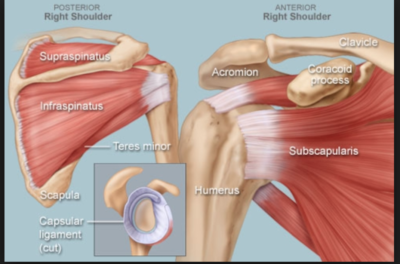
These four muscles that comprise the “cuff” include the supraspinatus, infraspinatus, teres minor and subscapularis, pictured above.
These muscles are responsible for, in order: abduction of the shoulder, external rotation and internal rotation. They work together as well to provide a stability cuff for the shoulder to support the congruency between the humeral head in the fossa of the scapula. Another muscle that helps to stabilize the shoulder blades themselves, the scapula, is the serratus anterior:
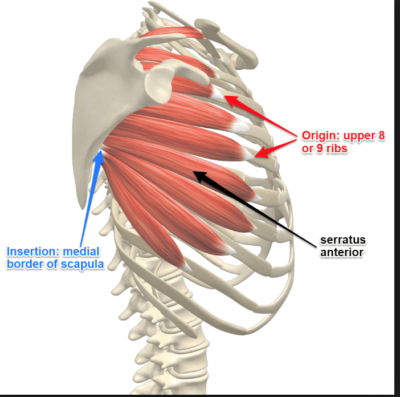
As you can see, the serratus anterior originates on the ribs and runs to the medial (midline) of the shoulder blades. So, when it contracts, it connects the shoulder blades to the back with a bit more “grip.” This muscle is what you want to use when you move into Low Push Up, as you’d not want to elevate the shoulder blades using the trapezius. That’s why you often hear teachers suggest you “wrap your elbows in” when you move into Low Push Up. This action contracts the serratus and will draw the scapula closer to the back.
One other aspect of anatomy to consider is the contribution of fascia and the health of fascia to movement. Fascia is the connective tissue layer that resides under the skin and before the muscle layer although it goes around and in between muscles and organs as well. Fascia’s relationship to the muscles has a huge impact on the range of motion one gets at any joint in the body and given all the muscles in the shoulder region, the importance of having healthy fascia cannot be overlooked. Ideally, the quality of fascia itself is such that the collagen fibers have a healthy wave pattern to them. The relationship of muscles to fascia should also be one that is “slide/glide” meaning there is a lack of grip and stickiness that prohibits healthy movement.
Bringing health to fascia relies on massage and what’s called myofascial release (myo=muscle, fascia=fascia). To release the fascia, the application of pressure is used through tools like massage balls and foam rollers. In order to allow students in this weekend’s workshop to experience the impact of this, we included massage ball rolling of the muscles into the workshop’s agenda. Rolling and compression, along with other techniques brings hydration to the tissues, restores the healthy collagen wave and also facilitates the “sliding and gliding” of muscles with respect to the nearby fascia.
Just to give you an idea of how this looked in the workshop, first we practiced, then we looked at the muscles through a quick presentation:
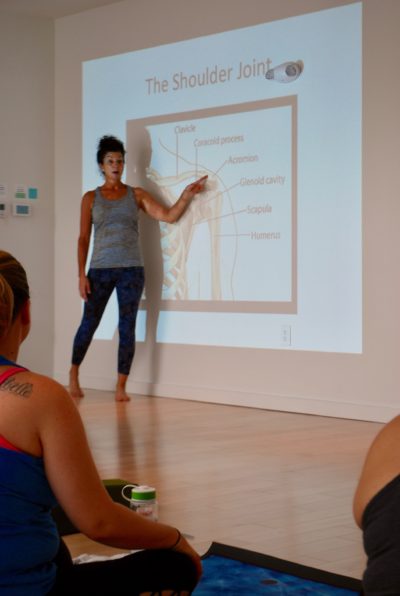
We then marked each muscle with kinesiotape:
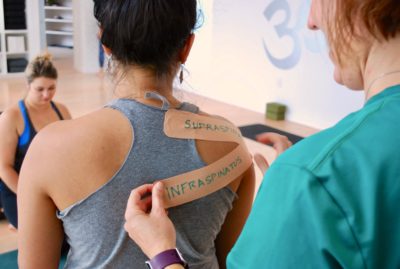
We then used the massage balls to perform MFR:Â
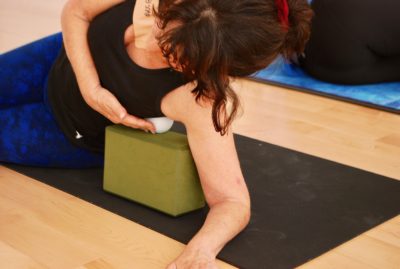
Then we went back to practice and focused on specific poses that require shoulder stability. In this forward fold, with good stability at the floor and good alignment, you can trigger the serratus anterior’s contractibility and feel the strength of the muscle:
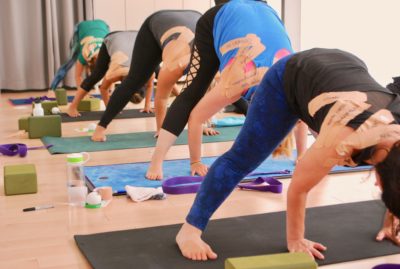
Learning in a multi-faceted way is a great way to make the content “stick.”
If you’re in or near Boston, I’m repeating this workshop format on October 6th at Yoga Works in Cambridge. You can sign up here.Â
The last day for early registration is the 29th so if you’d like to come, sign up by then!
If you’re looking for a virtual way to learn anatomy, take my LEARN ANATOMY CHALLENGE. This series of free videos will walk you through key aspects of anatomy. To get started, download the guide here.Â
So, what ways do YOU like to learn anatomy? Comment below!
Thanks for reading!
